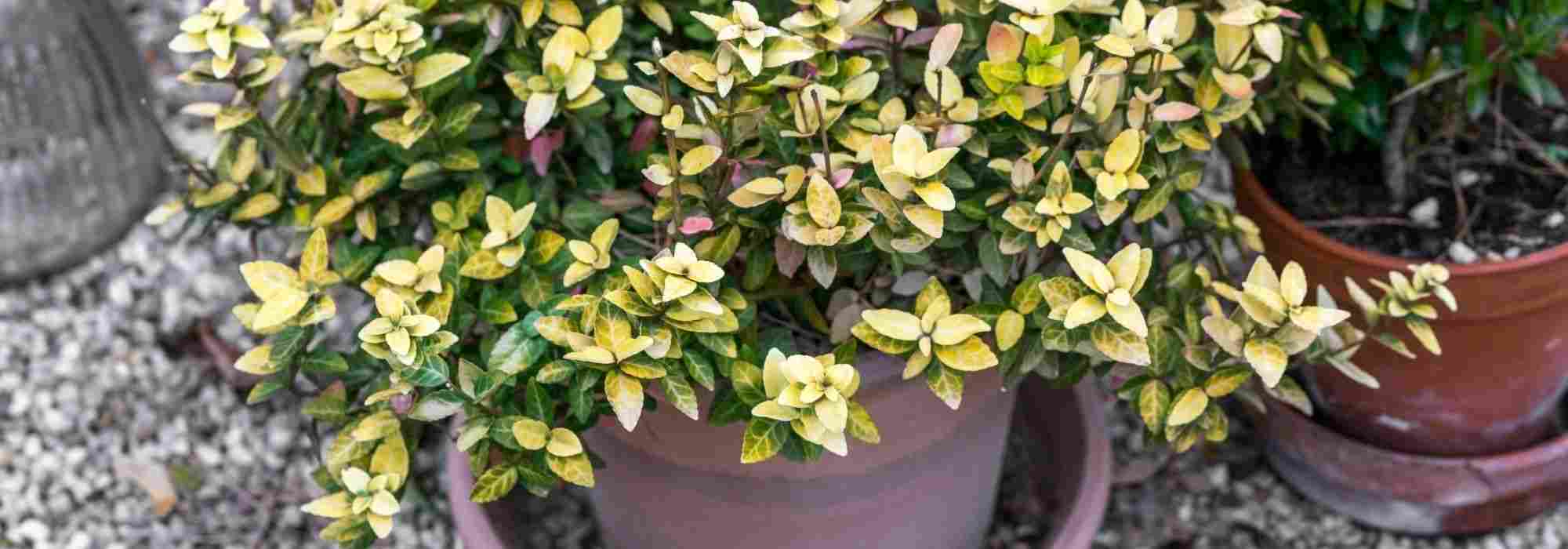
Growing an evergreen spindle tree in a pot
All our tips
Contents
Although it is very often planted in the ground (in hedges, as a specimen, or in rockeries), the spindle tree is also perfectly suited for pot planting. Truly decorative throughout the year, the evergreen species and varieties adorn terraces and balconies with their dense, leathery foliage, whether solid or variegated. Very hardy and requiring only fresh, well-drained soil, evergreen spindle trees, such as Euonymus fortunei and the Japanese spindle tree Euonymus japonicus, offer a wide diversity of colours, habits, and sizes. Suitable varieties, required materials, planting, and care: discover all our tips for successfully growing evergreen spindle trees in pots!
Which spindle tree should you choose for pot planting?
Among the evergreen spindle trees, the most well-known are: Euonymus fortunei and Euonymus japonicus. These two species of spindle trees offer a wide range of habits, heights, and colours, making them excellent for pot cultivation.
Not exceeding 50 cm in height, the dwarf evergreen spindle trees are well-suited for container gardening on small balconies:
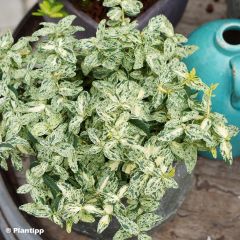
Euonymus fortunei Golden Harlequin - Spindle
- Flowering time June, July
- Height at maturity 30 cm
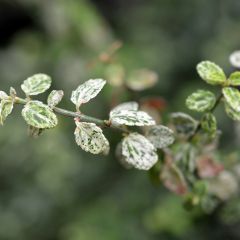
Euonymus fortunei Silverstone - Spindle
- Flowering time June, July
- Height at maturity 30 cm
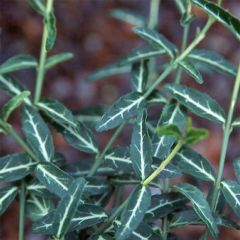
Euonymus fortunei var. radicans Wolong Ghost - Spindle
- Flowering time June, July
- Height at maturity 15 cm
For those under one metre tall, we offer varieties with stunning foliage:

Euonymus fortunei Goldy - Spindle
- Flowering time June, July
- Height at maturity 50 cm
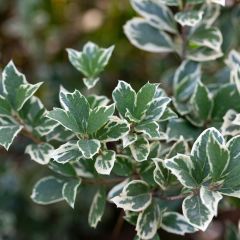
Euonymus fortunei Emerald Gaiety - Spindle
- Flowering time June, July
- Height at maturity 1 m
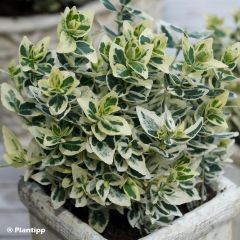
Euonymus fortunei Dans Delight - Spindle
- Flowering time June, July
- Height at maturity 50 cm
Others, naturally larger, can be placed in containers on terraces and can serve as privacy screens alongside other evergreen shrubs:

Euonymus japonicus Benkomasaki Erecta - Japanese Spindle
- Flowering time June to August
- Height at maturity 1,70 m
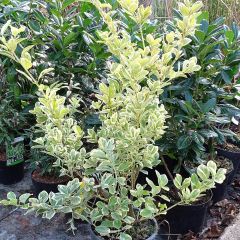
Euonymus japonicus Président Gauthier - Japanese Spindle
- Flowering time June to August
- Height at maturity 2 m

Euonymus japonicus White Spire - Japanese Spindle
- Flowering time June to August
- Height at maturity 1,50 m
What pot for the spindle tree?
For planting your evergreen spindle in a pot, the size of the container depends on the species or variety you have chosen. For large mature specimens, choose a container of substantial size to accommodate your bush in a large volume of soil. In this case, allow for a minimum of 50 cm in diameter (or width) and the same in depth. However, be aware that in a pot, a spindle will not grow as tall as it would if planted in the ground. Groundcover spindles are fine with a pot of 30-40 cm in diameter and depth.
Regarding the material of the container, we recommend using a terracotta pot. This material is porous, promoting better natural aeration of the substrate while also retaining moisture better than plastic pots. Additionally, be sure to choose a container with a drainage hole at the bottom. This allows excess watering or rainwater to drain away effectively.

Adjust the size of the pot according to the height at maturity of your evergreen spindle. On the right, Euonymus fortunei ‘Emerald’n Gold’ shaped into a topiary.
Discover other Euonymus - Spindle tree
View all →Available in 3 sizes
Available in 3 sizes
Available in 4 sizes
Available in 2 sizes
Available in 2 sizes
Available in 2 sizes
Available in 1 sizes
Available in 2 sizes
Available in 2 sizes
Available in 2 sizes
What substrate to use?
For your container of evergreen spindle, make a mixture formed of ⅓ potting soil, ⅓ rich garden soil, and ⅓ coarse sand. The important thing is to provide freshness to the roots of your plant while avoiding waterlogged soil. To achieve this, a drainage layer at the bottom of the container is necessary: clay balls, gravel, broken terracotta, pumice, … Please note that evergreen spindles prefer neutral to calcareous soils, unlike deciduous spindles which are indifferent to soil pH. An organic mulch is recommended (wood chips, dead leaves, RCW…). This provides nourishment to your bush as it decomposes and limits the substrate from drying out too quickly.
Read also
Spindle: which variety to choose?How to plant spindle in a pot?
When to proceed?
For pot cultivation, planting can be done all year round. However, to encourage good establishment of the bush, it is preferable to plant the evergreen spindle in a pot:
- either in spring, between late March and May,
- or in autumn from September to November.
Avoid any planting during frost or extreme heat.
How to proceed?
- Soak the root ball of your evergreen spindle to properly moisten it and eliminate any air pockets.
- In the meantime, place a draining layer at the bottom of your pot. A thickness of about 5-8 cm is sufficient. You can also lay a piece of geotextile fabric over the drainage to prevent the substrate from escaping through the holes of your container during watering;
- Fill the pot three-quarters full with your substrate mix;
- Remove your plant from its pot and gently untangle the roots (they should not form a tangle);
- Manually create a hole and place your plant in it. The top of the root ball should be a few centimetres from the edge of the pot;
- Fill the gap around the spindle with the remaining mix;
- Press down by hand to ensure the substrate adheres well to the roots. Add more substrate if necessary;
- Water generously;
- Cover with organic mulch.
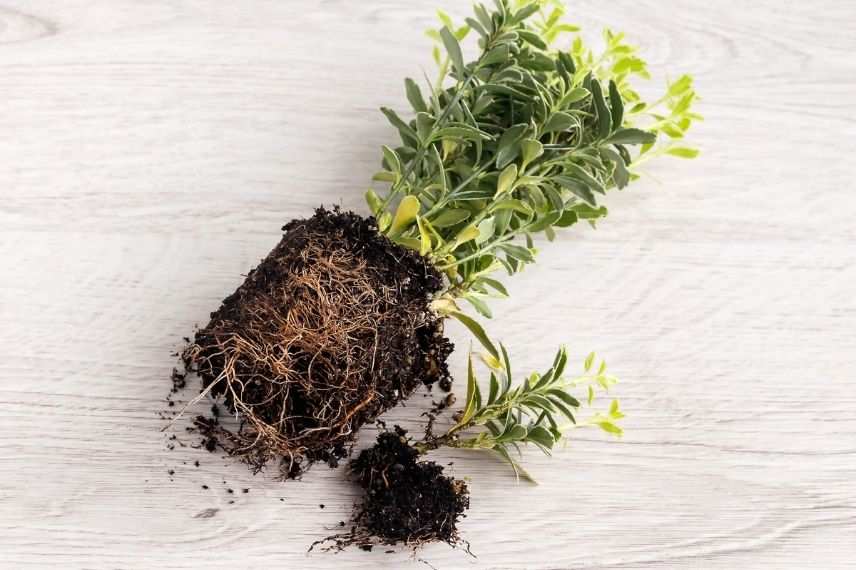
At the time of planting, ensure that no root tangle has formed during the growth of your evergreen spindle.
What exposure does a pot-grown spindle tree need?
Place your potted euonymus in a sunny or semi-shaded spot. If you live in a very hot region during summer, favour partial shade. Also note that variegated species and varieties look better in partial shade, where they provide a lovely touch of brightness. Remember to protect the potted euonymus from cold, drying winds. To prevent the appearance of diseases like powdery mildew, ensure there is enough space around your potted euonymus. Indeed, confined and poorly ventilated areas are conducive to the development of fungi.
How to care for a potted spindle tree?
Watering
Watering the potted spindle must be regular, as the substrate dries out faster than in the ground. Water once a week in spring and summer, and twice a week, or more in case of summer drought. The substrate should simply remain moist and cool. In autumn, gradually space out the waterings, stopping them in winter. To ensure that the mulch remains effective in protecting the bush against drought and frost, remember to add more in spring or winter, as it decomposes over time.
Fertiliser Application
To help young spindles establish, a fertiliser application is necessary at planting. You can use a slow-release fertiliser such as crushed horn, which aids in better root development.
In the following years, in spring, you can moderately apply an organic “boost” fertiliser, only if your spindle shows signs of weakness (for example, dried blood scratched at the base of the plant).
Pruning
A light pruning can be carried out on the potted spindle in autumn, possibly in spring. This involves shortening the leafy stems by a few centimetres to encourage branching of the bush and to maintain a nice shape.
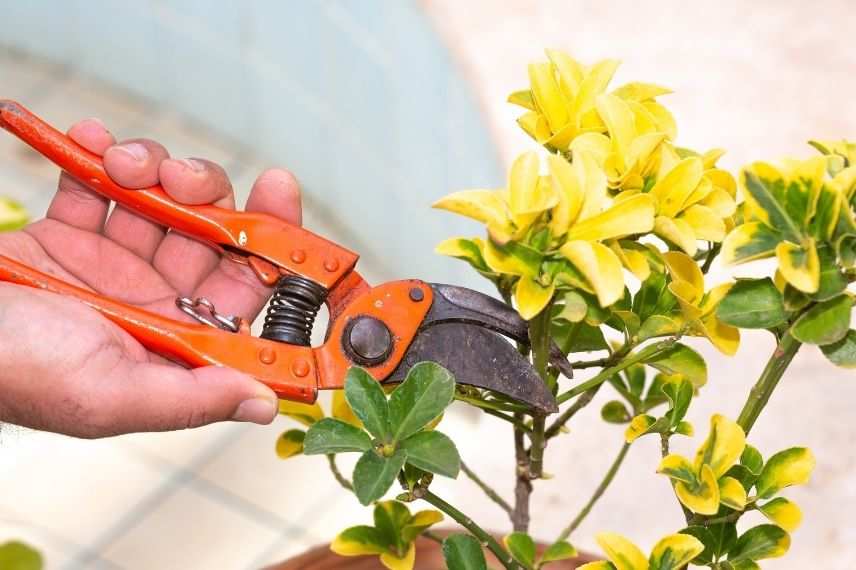
Pruning the tips of the branches stimulates the bush, which will produce more branches subsequently.
Top Dressing
If your container is large enough for your bush, annual repotting is not necessary. Each spring, simply replace the top 5 to 7 centimetres of substrate with a mix of fresh potting soil and well-rotted compost.
Winter Protection
Evergreen spindles are generally very hardy. Fortunei spindles tolerate severe cold down to -28 °C, but Japanese spindles are more delicate (maximum -12 °C). However, potted roots are at greater risk of freezing than those in the ground. It is best to protect young specimens, especially if you are in very cold regions. Here are our tips:
- If possible, bring your container indoors, storing it away from the cold before the first frosts.
- If not, add mulch. Remove the saucer to prevent standing water from freezing. Elevate your pot using wooden blocks. Insulate the pot with straw, leaves, bubble wrap, or geotextile. Protect the foliage with fleece. In case of snow, shake the spindle to prevent branches from breaking under the weight of the snow.
For further reading
- Discover our wide range of spindle trees: the most beautiful varieties, deciduous or evergreen
- Find our tips to identify, prevent, and combat the diseases and pests of Japanese spindle
- Subscribe!
- Contents
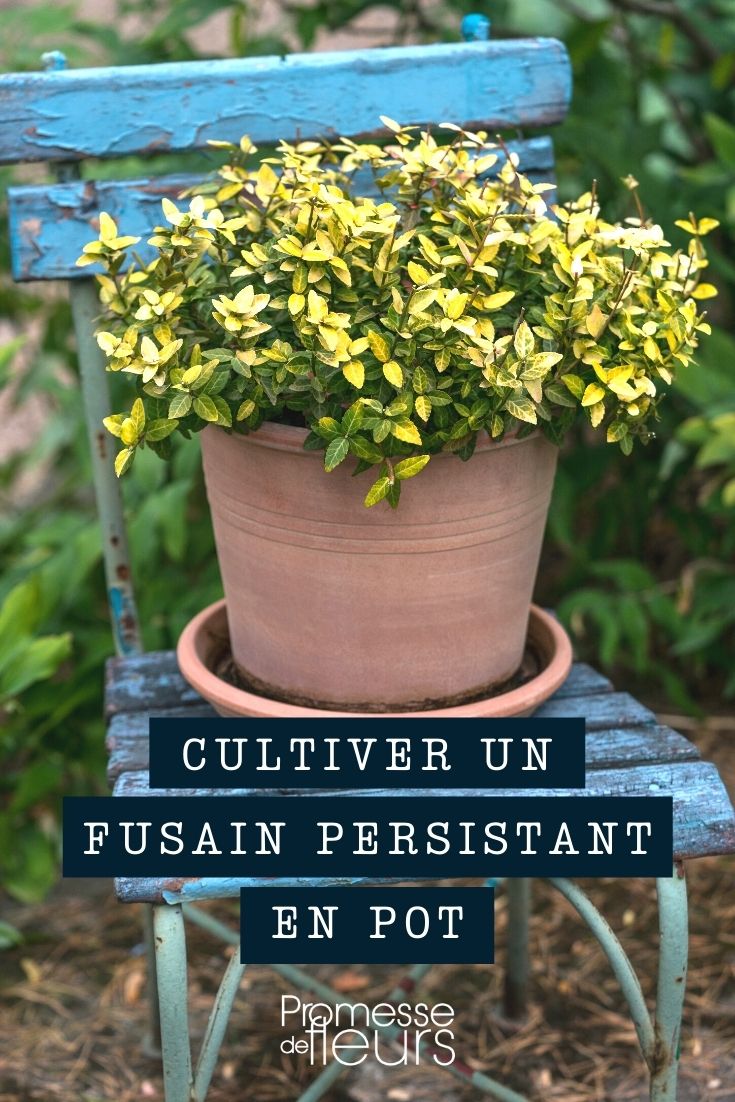


































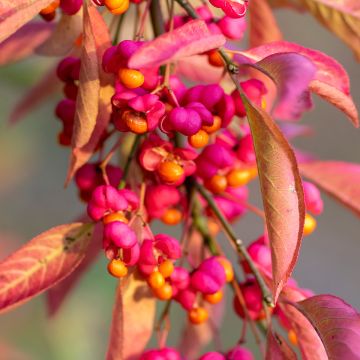

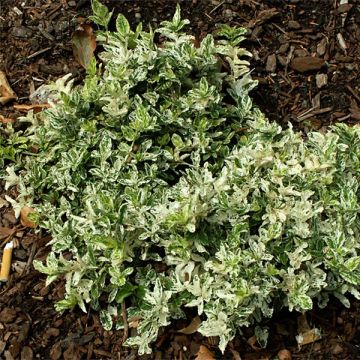
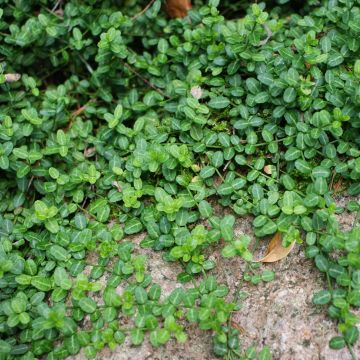



Comments